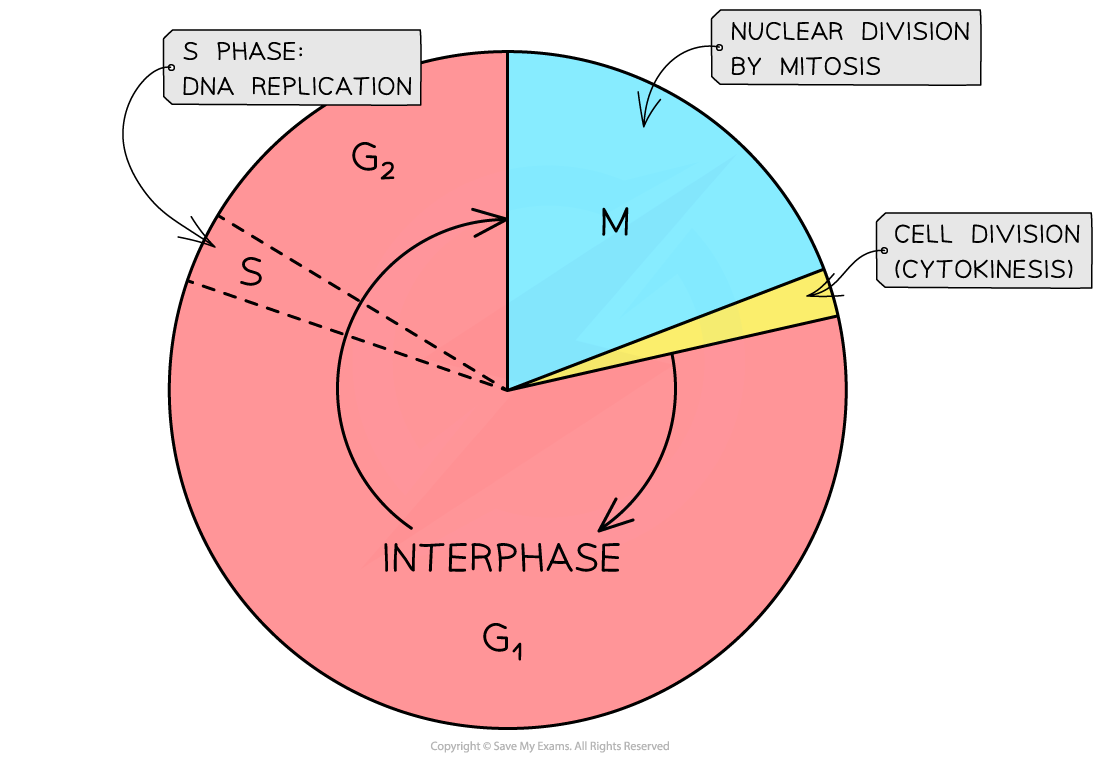The Cell Cycle (OCR A Level Biology) : Revision Note
The Cell Cycle
Mitosis is part of a precisely controlled process known as the cell cycle
The cell cycle is the regulated sequence of events that occurs between one cell division and the next
The cell cycle has three phases:
interphase
nuclear division (mitosis)
cell division (cytokinesis)
The length of the cell cycle is very variable depending on environmental conditions, the cell type and the organism
For example, onion root tip cells divide once every 20 hours (roughly) but human intestine epithelial cells divide once every 10 hours (roughly)
The movement from one phase to another is triggered by chemical signals called cyclins

The cell cycle. S = synthesis (of DNA); G = growth; M = mitosis
Interphase
During Interphase the cell increases in mass and size and carries out its normal cellular functions (eg. synthesising proteins and replicating its DNA ready for mitosis)
Interphase consists of three phases:
G1 phase
S phase
G2 phase
It is at some point during the G1 phase a signal is received telling the cell to divide again
The DNA in the nucleus replicates (resulting in each chromosome consisting of two identical sister chromatids)
This phase of the interphase stage of the cell cycle is called the S phase – S stands for synthesis (of DNA)
The S phase is relatively short
The gap between the previous cell division and the S phase is called the G1 phase – G stands for growth
Cells make the RNA, enzymes and other proteins required for growth during the G1 phase
Between the S phase and next cell division event the G2 phase occurs
During the G2 phase, the cell continues to grow and the new DNA that has been synthesised is checked and any errors are usually repaired
Other preparations for cell division are made (eg. production of tubulin protein, which is used to make microtubules for the mitotic spindle)
Interphase = G1 + S + G2
Nuclear division (mitosis)
Follows interphase
Referred to as the M phase – M stands for mitosis
Cell growth stops during the M phase
Cytokinesis
Follows M phase
Once the nucleus has divided into two genetically identical nuclei, the whole cell divides and one nucleus moves into each cell to create two genetically identical daughter cells
In animal cells, cytokinesis involves constriction of the cytoplasm between the two nuclei and in plant cells, a new cell wall is formed

Flow cytometry can be used to measure the mass of DNA in a sample of cells throughout a cell cycle.
Examiner Tips and Tricks
Make sure you know the order of the phases of the cell cycle but also what specifically occurs during the different phases. Don’t forget, interphase is itself made up of three distinct stages (G1, S and G2) and you need to know what happens during each of these.For example, an exam question might ask you to identify the stage of the cell cycle during which a cell would be producing the most mRNA molecules and explain why. The correct answer would be the G1 phase, as this is when protein synthesis is occurring and the production of mRNA occurs during transcription (the first part of protein synthesis).
Regulation of the Cell Cycle
It is essential that the DNA within new cells is accurate in order for them to carry out their function
When the DNA is replicated (during the S phase) errors can occur
There are several checkpoints throughout the cell cycle where the genetic information contained within the replicated DNA is checked for any possible errors
Specific proof-reading enzymes and repair enzymes are involved in this checking process
When possible enzymes will repair the error but in some cases the cell may destroy itself to prevent passing on harmful mutations
There are four checkpoints in the cell cycle:
During G1 phase - chromosomes are checked for damage. If damage is detected then the cell does not advance into the S phase until repairs have been made
During S phase - chromosomes are checked to ensure they have been replicated. If all the chromosomes haven't been successfully replicated then the cell cycle stops
During G2 phase - an additional check for DNA damage occurs after the DNA has been replicated. The cell cycle will be delayed until any necessary repairs are made
During metaphase - the final check determines whether the chromosomes are correctly attached to the spindle fibres prior to anaphase

You've read 0 of your 5 free revision notes this week
Unlock more, it's free!
Did this page help you?
